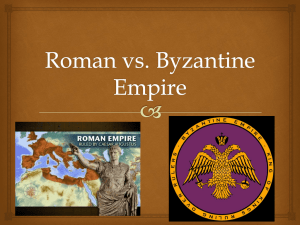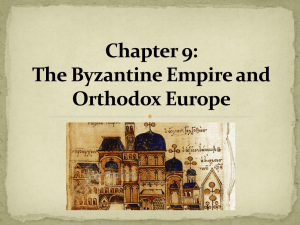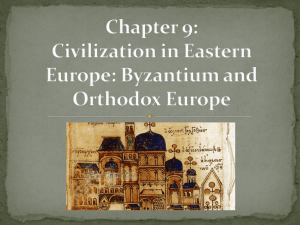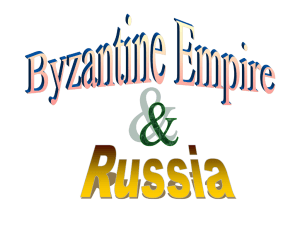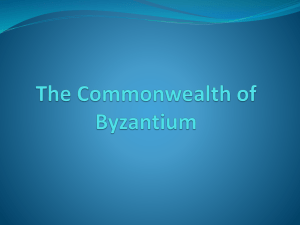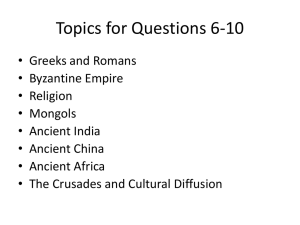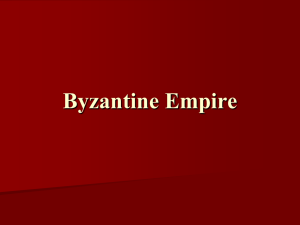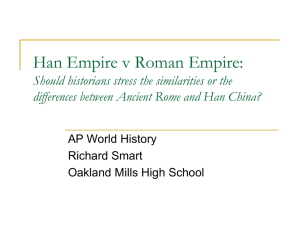Chapter 9 Civilizations in Eastern Europe: Byzantium and Orthodox
advertisement
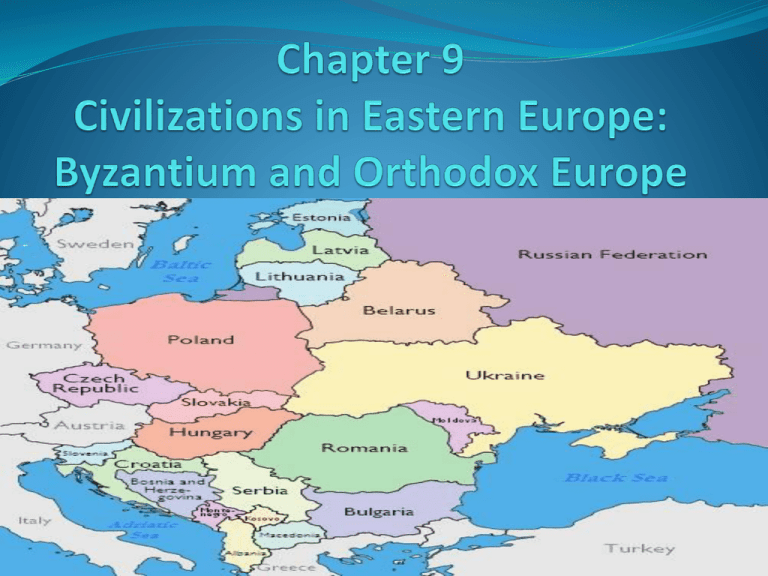
Chapter Summary The byzantine Empire in western Asia and SE Europe expanded into eastern Europe Catholicism influenced western and central Europe The byzantine empire had territories in the Balkans, the Middle East and eastern Mediterranean The Byzantium empire maintained very high levels of political, economic, and cultural life between 500 and 1450 CE The empire continued many Roman patterns and spread orthodox Christianity The Byzantine Empire Once part of the greater Roman empire Continued from a eastern Mediterranean after Roman decline Although there were roman patterns it copied the empire developed its own form of civilization The Origins of the empire Emperor Constantine in the 4th cent. CE established a capital at Constantinople Latin was the court language Greek became the official language after the 6th cent. The empire benefitted from a high level of civilization in the Hellenistic world It developed a trained civilian bureaucracy Justinian’s Achievements Attempted to reconquer western territory but without lasting success Military efforts weakened the empire as Slavs and Persians attacked the frontiers Justinian rebuilt Constantinople in the classical style; among the architectural achievements was the church of Hagia Sophia Justinian codified Roman law which later spread throughout Europe Arab pressure and the empires Defenses The empire was centered in the Balkans and western and central turkey This location blended a rich Hellenistic culture with Christianity The revived empire withstood the 7th cent. Arab advance The wars and permanent Muslim threat had significant cultural and commercial influences Arab pressure and the empires Defenses The free rural population, the provider of military recruits and taxes, was weakened Aristocratic estates grew larger and aristocratic generals became stronger The empires fortunes fluctuated as it resisted pressure from Arab and Slavic kingdoms Bulgaria was a strong rival, but Basil II defeated and conquered it in the 11th cent. Byzantine Society and Politics Politics resembled the earlier Chinese system An emperor was ordained by god and surrounded by elaborate court ritual headed by both church and state Women occasionally held the throne Officials were trained in Hellenistic knowledge in a secular school system Provincial governors were appointed from the center and a spy system helped preserve loyalty Byzantine Society and Politics Military organization defended the empire Troops were recruited locally and given land for service The empire socially and economically depended on Constantinople's control of the countryside The bureaucracy regulated trade and food prices A wide spread commercial network extended into Russia, Asia, Scandinavia, western Europe and Africa Despite the busy trade merchants never developed political power Cultural life centered on Hellenistic secular traditions and orthodox Christianity The split between Eastern and Western Christianity Byzantine culture, political orgainizati0n and economic orientation help to explain the rift between eastern and western versions of Christianity Different rituals grew from Greek and Latin versions of the bible Emperors resisted papal attempts to interfere in religious issues Charlemagne, the first Frankish king, tried to be recognized as Roman emperor In 1054 the final break occurred over arguments about the type of bread to use in the mass and the celibacy of the priests The Empires Decline Decline began in the 11th cent. Muslim Turkish invaders seized most of the empire’s provinces in Asia, removing the most important sources of taxes and food The empire never recovered from the loss of its army at Manzikert in 1071 Independent Slavic states appeared in the Balkans Crusades, led by Venetian merchants, sacked constantinople in 1204 Italian navies were used to secure special trading priovileges In 1453 the Ottoman turks conquered Constaninople The spread of Civilization in Eastern Europe Byzantine empire influenced spread among the people of the Balkans and southern Russia through conquest, commerce and Christianity 9th cent. missionaries, Cyril and Methodius devised a written script, Cyrillic This script was for the Slavic language to provide a base for literacy in eastern Europe Unlike western Christians, the Byzantines allowed the use of local languages in church services The east central borderlands East and west Christians competed in eastern Europe Roman Catholics and their Latin alphabet prevailed in Czechoslovakia, Hungary and Poland A series of regional monarchies- Poland, Bohemia, Lithuania-with powerful land-owning aristocracies developed Eastern Europe received an influx of Jews from the Middle East western Europe The emergence of Kievan Rus’ Slavic people from Asia migrated into Russia and eastern Europe during the period of the Roman empire They possessed iron and extended agriculture in the Ukraine and western Europe Political organization centered in the family tribes and villages The Slavs followed an animist religion and had a rich tradition of music and oral legends The emergence of Kievan Rus’ A monarchy emerged at Kiev around 855 under the Danish merchant, Rurik Kiev became a prosperous commercial center Contacts with the Byzantines resulted in the conversion of Vladimir I (980-1015) to orthodox Christianity Kiev’s rulers issued a formal law code Institutions and Culture in Kievan Rus Kiev borrowed much from Byzantium but it was unable to duplicate its bureaucracy or education system Cultural, social, and economic patterns developed differently from western European experience Rulers favored Byzantine ceremonials and the concept of a strong central ruler Orthodox Christian practices entered Russian culture Almsgiving emphasized the obligation of the wealthy to the poor Literature focused on religious and royal events Kievan decline Decline began in the 12th cent. Rival princes established competing gov. while the royal family fought over succession Asian invaders seized territory as trade diminished because of Byzantine decay Mongol invasions of the 13th cent. incorporated Russia into its territory Kievan decline Russian Orthodox Christianity survived because the tolerant mongol rulers didn’t interfer with Russian religious beliefs or daily life as long as tributes were paid In the 15th cent mongol control ends and the russian cultural and political tradition incorporating the Byzantine inheritance reemerged The Russians claimed to be the successors to the Roman and Byzantine states, the 3rd Rome The end of an era in eastern Europe Mongol invasions, the decline of Russia and the collapse of Byzantium eastern Europe entered into a difficult period Border territories such as Poland fell under western influence The Balkans fell to the Islamic world of the Turks Western and eastern Europe evolved separately, with the east pushing ahead in power and cross-cultural sophistication


